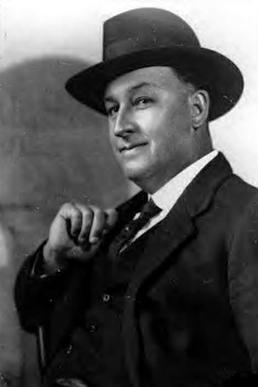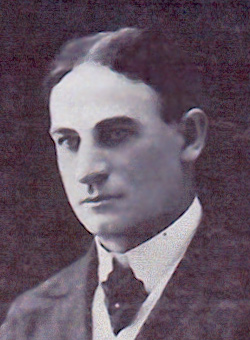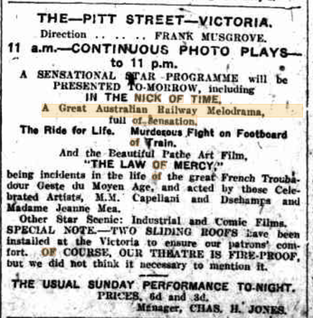Related Research Articles

Robbery Under Arms is a 1920 Australian film directed by Kenneth Brampton and financed by mining magnate Pearson Tewksbury. It is an early example of the "Meat pie Western".

Raymond Longford was a prolific Australian film director, writer, producer, and actor during the silent era. Longford was a major director of the silent film era of the Australian cinema. He formed a production team with Lottie Lyell. His contributions to Australian cinema with his ongoing collaborations with Lyell, including The Sentimental Bloke (1919) and The Blue Mountains Mystery (1921), prompted the Australian Film Institute's AFI Raymond Longford Award, inaugurated in 1968, to be named in his honour.

Albert Edward Bailey, better known as Bert Bailey, was a New Zealand-born Australian playwright, theatrical manager and stage and screen actor best known for playing Dad Rudd, in both mediums, the character from the books penned by Steele Rudd.
The Mark of the Lash is a 1911 Australian silent film. It is a convict-era melodrama made by the husband-and-wife team of John and Agnes Gavin.

Alfred Rolfe, real name Alfred Roker, was an Australian stage and film director and actor, best known for being the son-in-law of the celebrated actor-manager Alfred Dampier, with whom he appeared frequently on stage, and for his prolific output as a director during Australia's silent era, including Captain Midnight, the Bush King (1911), Captain Starlight, or Gentleman of the Road (1911) and The Hero of the Dardanelles (1915). Only one of his films as director survives today.
The Road to Ruin is an Australian melodrama film directed by W. J. Lincoln. It was one of the first movies from Lincoln-Cass Films and is considered a lost film.

The Double Event is a 1911 Australian feature-length film directed by W. J. Lincoln based on the first novel by Nat Gould, which had been adapted several times for the stage, notably by Bland Holt.

Captain Midnight, the Bush King is a 1911 Australian silent Western film about the fictitious bushranger Captain Midnight. It was the directorial debut of actor Alfred Rolfe. The film is based on the play of same name by W. J. Lincoln and Alfred Dampier. Captain Midnight, the Bush King is now considered lost.
Captain Starlight, or Gentleman of the Road is a 1911 Australian silent film about the bushranger Captain Starlight. It was based on Alfred Dampier's stage adaptation of the 1888 novel Robbery Under Arms. It is considered a lost film.
The Life of Rufus Dawes is a 1911 Australian silent film based on Alfred Dampier's stage adaptation of the 1874 novel For the Term of His Natural Life produced by Charles Cozens Spencer.

The Lady Outlaw is a 1911 Australian silent film set in Van Diemen's Land during convict days.

In the Nick of Time is a 1911 Australian silent film directed by Alfred Rolfe. It was described as a "sensational railway drama", although now is considered a lost film.
The Cup Winner is a 1911 Australian silent film directed by Alfred Rolfe. It is set against a backdrop of horseracing and the finale involves real footage from the 1911 Melbourne Cup.
Caloola, or The Adventures of a Jackeroo is a 1911 Australian silent film directed by Alfred Rolfe based on a novel published the previous year by Clement Pratt.
King of the Coiners is a 1912 Australian silent film directed by Alfred Rolfe. It is considered a lost film.
Do Men Love Women? is a 1912 Australian silent film directed by Alfred Rolfe about an alcoholic who reforms through the love of a good woman. The finale featured a railway collision.
The Sin of a Woman is a 1912 Australian silent film directed by Alfred Rolfe.
The Cheat is a 1912 Australian silent film directed by Alfred Rolfe. It is considered a lost film.
Won on the Post is a 1912 Australian silent film directed by Alfred Rolfe set against a backdrop of horseracing.
The Australian Photo-Play Company was a short-lived but highly productive Australian film production company which operated from 1911 to 1912.
References
- ↑ "Advertising". The Grenfell Record and Lachlan District Advertiser . NSW: National Library of Australia. 19 December 1911. p. 2. Retrieved 13 September 2013.
- 1 2 Andrew Pike and Ross Cooper, Australian Film 1900–1977: A Guide to Feature Film Production, Melbourne: Oxford University Press, 1998, p 24
- ↑ Vagg, S., & Reynaud, D. (2016). Alfred Rolfe: Forgotten pioneer Australian film director. Studies in Australasian Cinema, 10(2),184-198. doi:10.1080/17503175.2016.1170950
- ↑ "What Women Suffer". The Cairns Post . Qld.: National Library of Australia. 17 May 1912. p. 8. Retrieved 26 February 2012.
- ↑ "What Women Suffer". The Cairns Post . Qld.: National Library of Australia. 17 May 1912. p. 8. Retrieved 13 September 2013.
- ↑ "EMPRESS PAVILION". Williamstown Chronicle . Vic.: National Library of Australia. 14 October 1911. p. 3. Retrieved 13 September 2013.
- ↑ "OLD PROGRAMMES". The Morning Bulletin . Rockhampton, Qld.: National Library of Australia. 1 February 1936. p. 5. Retrieved 26 February 2012.
- ↑ "HIS MAJESTY'S MOVING THEATRE". The Morning Bulletin . Rockhampton, Qld.: National Library of Australia. 4 June 1909. p. 5. Retrieved 26 February 2012.
- ↑ ""WHAT WOMEN SUFFER."". The Sydney Morning Herald . National Library of Australia. 23 September 1912. p. 3. Retrieved 8 December 2012.
- ↑ "News and Notes". The Coburg Leader (Vic. : 1890–1913) . Vic.: National Library of Australia. 6 October 1911. p. 1. Retrieved 13 September 2013.
- ↑ "VICTORIA PICTURES". The Sunday Times . Sydney: National Library of Australia. 15 October 1911. p. 2. Retrieved 13 September 2013.
- ↑ "Advertising". The Advertiser . Adelaide: National Library of Australia. 25 November 1911. p. 2. Retrieved 13 September 2013.
- ↑ "NOTES AND EVENTS". The Colac Herald . National Library of Australia. 5 January 1912. p. 2. Retrieved 13 September 2013.
- ↑ "AUSTRALIAN CINEMATOGRAPHY". The Evening News . Sydney: National Library of Australia. 26 September 1911. p. 4. Retrieved 21 November 2014.